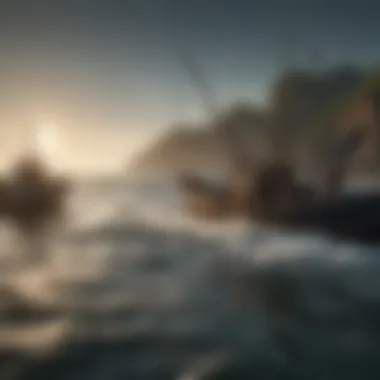Innovative Strategies for Ocean Preservation


Research Overview
The preservation of oceanic environments has gained significant attention in recent years due to their vital role in sustaining biodiversity, regulating the climate, and supporting human communities. Understanding the complexities involved in ocean conservation is paramount.
Summary of Key Findings
Research consistently shows that marine ecosystems are under immense threat from factors such as pollution, overfishing, and climate change. Recent data indicates a drastic decline in fish populations, with some species seeing a reduction of over 70% in the last few decades. Moreover, coral reefs, which provide habitat for countless marine species, have experienced severe bleaching events linked to rising ocean temperatures. These findings underscore the urgency to adopt comprehensive strategies for preservation.
Background and Context
Historically, the ocean has been viewed as an infinite resource, leading to unsustainable practices that have jeopardized its health. Over the years, academic studies have illuminated the direct correlation between human activities and marine degradation. The narrative has shifted from exploitation to conservation, emphasizing the need for integrated approaches that consider ecological dynamics and socioeconomic realities.
Methodology
Addressing these challenges requires a robust methodological framework. The combination of interdisciplinary research, technological innovation, and policy advocacy forms the backbone of effective ocean preservation efforts.
Experimental Design
Studies focus on creating models that predict the outcomes of various conservation strategies. These models typically include variables such as species diversity, fishing rates, and pollution levels. Control and experimental sites are established to test hypotheses regarding the effectiveness of different strategies, from marine protected areas to sustainable fishing practices.
Data Collection Techniques
Data collection involves multiple techniques. Surveys and field studies provide quantitative data about marine species and habitats. Remote sensing technology enables scientists to monitor ocean conditions and health from afar. The integration of citizen science, where local communities contribute observations, enriches the data pool and strengthens community involvement in conservation efforts.
"Collaboration among stakeholders, including government entities, scientists, and local communities, is essential for sustainable marine management."
Researchers are beginning to understand that marine preservation is not solely a scientific endeavor but also a social one, dependent on human cooperation and policy enforcement. This multifaceted approach positions us to mitigate the adverse effects on our oceans.
Preface to Ocean Preservation
Ocean preservation is a critical concern that encompasses various aspects, from ecological health to human dependence on marine resources. The oceans are not just vast bodies of water; they are complex ecosystems that play a vital role in regulating the planet’s climate and supporting a diverse range of species. Moreover, they are resources for millions of people worldwide, providing food, employment, and recreational opportunities.
The conservation of oceanic environments serves numerous benefits. A healthy ocean supports biodiversity, which is essential for ecosystem resilience. It aids in carbon sequestration, thus mitigating climate change effects. With the degradation of these environments, we see not only a loss of biodiversity but also a threatening impact on the livelihood of communities dependent on ocean resources.
In our exploration of ocean preservation, we will delve into the current state of ocean health, the threats faced, and the strategies necessary for sustainable management. The future of our oceans hinges upon informed actions and cohesive strategies that can enhance marine conservation efforts.
Understanding the Importance of Oceans
The oceans are at the core of Earth’s biosphere. They support an intricate web of life, from microscopic phytoplankton to the largest whales. The oceans also regulate temperature and weather patterns through heat absorption and distribution. Furthermore, they are a source of oxygen, producing more than half of the world’s oxygen through photosynthesis carried out by marine plants.
Beyond ecological significance, oceans contribute to economic activities such as fishing, tourism, and shipping. These activities underpin the economies of many coastal communities. Understanding the importance of oceans is crucial not only for ecological integrity but also for the socio-economic fabric that many regions depend on.
Current State of Ocean Health
The current state of ocean health is alarming. Recent studies indicate that significant portions of coral reefs are deteriorating, while fish populations are declining. Factors such as pollution, overfishing, and climate change contribute to this decline. The presence of plastic waste has reached crisis levels, affecting marine life and entering the food chain.
Given these challenges, it is imperative to address the situation actively.
"The health of oceans directly reflects the well-being of the planet and its inhabitants."
Efforts to monitor ocean conditions are underway, yet they require enhanced funding and global collaboration. The data collected can inform better management practices to reverse the trends of degradation. Furthermore, understanding these issues allows for educational initiatives that can involve communities and stakeholders in conservation efforts.
In summary, acknowledging the importance of oceans and recognizing their current health status sets the stage for evaluating effective strategies for preservation. Only through comprehensive action can we hope to safeguard our oceans for future generations.
Threats to Marine Ecosystems
Understanding the threats to marine ecosystems is essential for formulating effective strategies aimed at their preservation. Oceans face numerous challenges, each impacting the delicate balance that sustains life underwater and on land. These threats not only endanger marine biodiversity but also affect human communities that rely on these ecosystems for livelihood, recreation, and other vital services. By identifying and comprehending these threats, we can address root causes and develop informed actions to mitigate their effects.
Climate Change and Ocean Warming
Climate change has emerged as a significant threat to oceans worldwide. The increasing concentration of greenhouse gases in the atmosphere translates to warmer ocean temperatures. This warming affects marine species, altering their habitats and migration patterns. For example, coral reefs, which are critically important for marine biodiversity, suffer from bleaching when water temperatures rise.


"Coral reefs are ecosystems that support numerous marine species, but they are particularly vulnerable to temperature changes."
Additionally, ocean acidification occurs as the ocean absorbs excess carbon dioxide. This chemical change impacts organisms such as shellfish and coral, which rely on calcium carbonate for growth. Consequently, the food web and fishing stocks are jeopardized. Addressing climate change through local and global policies is critical for safeguarding these ecosystems.
Pollution and Marine Debris
Pollution remains a pervasive threat to marine environments. The introduction of various pollutants—plastic waste, chemicals, and untreated sewage—degrades water quality and habitat. Plastic pollution, specifically, poses a significant risk, affecting marine life that ingests or becomes entangled in debris.
Marine debris can compromise the health of species and disrupt the natural behaviors necessary for survival and reproduction. Furthermore, pollutants can accumulate in the food chain, eventually impacting human health. Combating pollution requires comprehensive strategies, including stricter regulations on waste disposal and enhancing public awareness about reducing plastic use.
Overfishing and Resource Depletion
Overfishing is another critical threat that endangers marine ecosystems. Unsustainable fishing practices have led to the depletion of key species and disrupted the balance of marine life. When populations of fish and other marine organisms are overharvested, it creates a ripple effect throughout the ecosystem, affecting predator-prey relationships and altering habitat structures.
To combat overfishing, it is essential to implement sustainable fishing techniques and enforce catch limits. Encouraging the adoption of practices such as selective fishing gear can reduce bycatch and allow for the regeneration of fish stocks. Education and awareness among consumers about the source of their seafood can also contribute to more sustainable choices.
Habitat Destruction
Habitat destruction is a significant concern for marine conservation. Coastal development, bottom trawling, and other human activities lead to the degradation and loss of vital habitats such as wetlands, seagrass beds, and coral reefs. These habitats serve as nurseries for juvenile fish and provide shelter for countless marine species.
The negative consequences of habitat destruction extend beyond marine life; they also impact coastal communities that depend on healthy ecosystems for their livelihoods. To protect these habitats, policies and practices must focus on sustainable development, restoration efforts, and the establishment of marine protected areas.
Understanding and addressing these threats is essential to formulate coherent conservation strategies. The protection of marine ecosystems cannot be effective without acknowledging the challenges they face. Only through informed actions and a commitment to sustainable practices can we hope to secure the vitality of our oceans.
Sustainable Practices for Ocean Conservation
Implementing sustainable practices is vital for conserving oceanic environments. These practices not only help protect marine biodiversity but also contribute to the resilience of ecosystems against climate changes and human activities. The preservation of marine life is essential for maintaining the balance of global ecosystems. Sustainable practices ensure the longevity of ocean resources for future generations while supporting the livelihoods of coastal communities.
Sustainable Fishing Techniques
Sustainable fishing techniques are essential to mitigate the adverse impacts of overfishing. Traditional fishing practices often result in the depletion of fish stocks and disruption of marine ecosystems. Sustainable fishing focuses on methods that minimize environmental impacts while ensuring fish populations remain healthy. Techniques such as selective fishing gear help target specific species, reducing bycatch. Additionally, implementing catch limits allows fish populations to replenish.
Benefits of sustainable fishing practices include:
- Preservation of fish stocks: Allows fish to reproduce without pressure from high catch rates.
- Healthy marine ecosystems: Maintains the balance of species in the ocean.
- Support for local economies: Ensures fish populations support fishing communities long-term.
Marine Protected Areas
Marine protected areas (MPAs) are regions designated to conserve marine ecosystems. They restrict activities that can harm these environments, such as commercial fishing and industrial development. These areas play a crucial role in safeguarding biodiversity and providing safe havens for marine species.
The significance of MPAs includes:
- Biodiversity preservation: Protects habitats that support various marine life.
- Ecosystem recovery: Provides a refuge for depleted species, allowing for natural replenishment.
- Research and education: Offers locations for scientific study and public education on marine conservation.
Effective management of MPAs requires cooperation among governments, scientists, and local communities.
Reducing Single-Use Plastics
The reduction of single-use plastics is indispensable for the health of our oceans. Plastics contribute to marine pollution, strangling marine life and introducing harmful toxins into marine ecosystems. Single-use items, such as plastic bags and straws, often end up in the ocean rather than in trash bins. This form of pollution poses serious threats to marine biodiversity.
Strategies for reducing single-use plastics include:
- Public awareness campaigns: Educating individuals about the impact of plastic pollution.
- Legislation: Implementing bans on certain plastic products can decrease usage significantly.
- Promoting alternatives: Encouraging the use of reusable options effectively reduces reliance on single-use plastics.
"Taking measures to reduce single-use plastics not only protects marine life but also fosters a culture of sustainability among consumers."
Technological Innovations in Ocean Preservation
Technological innovations play a significant role in the preservation of ocean environments. These advancements are not merely conveniences; they are essential tools in the ongoing effort to conserve marine ecosystems. Given the vastness of oceans and the complexity of their ecosystems, leveraging technology can enhance our understanding of ocean health and streamline conservation efforts.
The integration of such technology offers several benefits. First, it allows for more precise monitoring of marine conditions. This data can inform better policy decisions. Second, technology can improve communication among stakeholders involved in ocean conservation. Finally, technological solutions can enhance community engagement in protection efforts. Without these tools, effective management of ocean ecosystems would be nearly impossible.
Remote Sensing and Monitoring


Remote sensing technology has revolutionized how we observe and manage ocean environments. It involves the use of satellites and aerial platforms to collect data about the sea surface and underwater conditions. Among various applications, monitoring water temperature, chlorophyll concentration, and sea level rise are crucial in understanding climate change impacts on oceans.
Some key points about remote sensing include:
- Data Collection: Satellites like Sentinel-2 and Landsat have been instrumental in gathering data that provides a comprehensive picture of ocean health.
- Real-time Monitoring: This technology allows scientists to monitor changes in marine ecosystems in real-time. Immediate data helps in adapting management strategies promptly.
- Accessibility: Information obtained through remote sensing is often shared publicly, making it accessible to a wider audience, including researchers and policy-makers.
These features are vital in creating a well-informed approach to ocean management. The visualization of data in maps and charts enhances understanding and facilitates collaboration among different organizations.
Biotechnology in Marine Ecosystems
Biotechnology offers various innovative solutions in the fight for ocean preservation. This field encompasses a range of techniques that utilize biological systems and organisms to address environmental challenges. In oceans, biotechnology can support species conservation, enhance aquaculture practices, and help in the restoration of marine habitats.
Considerations regarding biotechnology include:
- Genetic Engineering: It can help create resilient fish stocks capable of adapting to changing ocean conditions. Such advancements direct towards sustainable fishing practices.
- Bioremediation: This process uses microorganisms to clean up oil spills and other pollutants. By deploying engineered microbes, the degradation of hazardous materials can occur more efficiently.
- Sustainable Aquaculture: New techniques in this area aim to reduce the environmental impact of fish farming practices, ensuring protein supply while protecting marine resources.
"Biotechnology can transform our strategies for dealing with the challenges presented by marine degradation."
Policy and Governance Frameworks
The role of policy and governance frameworks in preserving the ocean cannot be overstated. These structures form the backbone of effective conservation efforts, ensuring that strategies are coherent, comprehensive, and inclusive. These frameworks dictate how resources are managed, provide accountability, and establish regulations that can curb destructive practices. They encourage cooperation among various stakeholders, which can include governmental bodies, non-governmental organizations, and local communities. When well implemented, these systems create a supportive environment for marine conservation and sustainable use of ocean resources.
International Agreements and Treaties
International agreements and treaties are essential for managing marine environments on a global scale. They create standardized protocols that countries can follow to protect shared marine resources. For example, the United Nations Convention on the Law of the Sea establishes guidelines for the use of ocean resources and ensures environmental protection. These agreements also facilitate cooperation in scientific research, enabling countries to share data and best practices. This collective approach is crucial since ocean issues often transcend national borders.
Key international treaties include:
- Convention on Biological Diversity (CBD): Focuses on conserving biodiversity, sustainable use of resources, and fair sharing of benefits.
- Paris Agreement: Aimed at combatting climate change, which indirectly helps protect ocean health by addressing global temperature rise.
- Regional Fisheries Management Organizations (RFMOs): Manage fish stocks across international waters to prevent overfishing.
International cooperation is vital in establishing a comprehensive strategy that considers the diverse challenges facing marine ecosystems around the world.
National Policies on Marine Protection
National policies play a critical role in translating international commitments into actionable strategies at the local level. Each country must develop tailored measures that address its unique marine environment, socioeconomic context, and cultural values. This may include establishing marine protected areas, regulating fishing activities, and addressing pollution. National policies should align with international agreements but also consider local communities' needs and knowledge.
Effective national policies include:
- Implementation of Marine Spatial Planning: This approach organizes human activities in marine areas to minimize conflicts and environmental impact.
- Establishment of Marine Protected Areas: These zones restrict certain activities to protect biodiversity and regenerating habitats.
- Enforcement of Sustainable Fishing Laws: Regulations to prevent overfishing and ensure long-term fish population health.
When these policies are enacted, they promote sustainable practices and contribute to the health of marine ecosystems.
Community Involvement and Local Governance
Engaging local communities in governance enhances the effectiveness of ocean conservation efforts. Local knowledge and participation are vital in creating policies that are culturally relevant and effective. Communities often depend on marine resources for their livelihoods. Empowering them can foster stewardship and responsibility toward ocean health. Local governance structures can be tailored to fit the unique challenges faced by each community.
Considerations for community involvement include:
- Promotion of Local Stewardship Initiatives: Incentivizing community-led conservation efforts, like beach clean-ups or habitat restoration projects.
- Education and Training Programs: Enhancing knowledge on sustainable practices and the importance of ocean preservation.
- Creating Partnerships Between Communities and Governments: Establishing dialogue to ensure that community voices are heard in decision-making processes.
Ultimately, integrating community involvement strengthens the social fabric surrounding marine conservation efforts, fostering a sense of ownership and responsibility.
The importance of policy and governance frameworks in ocean preservation lies in their ability to create structured and inclusive approaches to conservation efforts. Through international agreements, national policies, and community engagement, we can build a sustainable future for our oceans.
Case Studies of Successful Conservation Efforts
Case studies serve as crucial examples in the field of ocean preservation. They provide not just evidence of successful strategies, but also insights into the challenges faced and overcome. By examining real-world scenarios, we can understand which methods yield positive results and how these can be adapted or replicated in other contexts. Successful conservation efforts can inspire collective action, highlight the importance of sustainable practices, and illustrate the significance of collaboration among various stakeholders, including governments, non-profits, and local communities.
The Great Barrier Reef Restoration
The Great Barrier Reef, a UNESCO World Heritage site, faces severe threats from climate change, coral bleaching, and pollution. However, restoration efforts in this region have shown promise. Scientifically informed initiatives have focused on coral propagation, habitat protection, and water quality enhancement.


Recent projects have involved replanting coral fragments in degraded areas. These fragments are nurtured in controlled environments before they are attached to the reef. This method has resulted in increased growth rates and resilience against bleaching events.
Moreover, community involvement is key. Local governments and volunteers have participated in monitoring and clean-up activities, which promotes awareness and education on marine ecosystems. Engaging the broader public ensures that a culture of conservation is fostered.
Benefits include:
- Enhanced biodiversity
- Increased tourism potential
- Strengthened local economies
However, challenges remain, particularly in adapting to the unpredictable impacts of climate change. Ongoing research and adaptive management strategies will be essential in sustaining these efforts.
Coral Triangle Initiative
The Coral Triangle, known for its astounding diversity of marine life, is considered the world’s marine biodiversity hotspot. The Coral Triangle Initiative (CTI) is a regional partnership aimed at preserving this unique environment through collaborative governance and sustainable management practices.
Established in 2009, the CTI involves six countries: Indonesia, Malaysia, Papua New Guinea, Philippines, Solomon Islands, and Timor-Leste. This collaboration focuses on several key strategies:
- Improving the management of marine protected areas
- Reducing overfishing and illegal fishing practices
- Mitigating the effects of climate change
The initiative encourages knowledge sharing among member nations and emphasizes sustainable fishing practices that balance ecological health with economic needs.
The advantages of the CTI include:
- Coordinated conservation efforts across borders
- Economic stability for coastal communities
- Protection of vital marine resources
Despite these successes, challenges persist. Political will and funding inconsistency can hinder long-term progress. Nonetheless, the collaborative framework of the CTI serves as a powerful model for regional conservation efforts worldwide.
"By learning from these case studies, we can develop more effective strategies for safeguarding our oceans and fostering sustainable living habits across diverse populations."
Ultimately, the stories of restoration in the Great Barrier Reef and the collaborative governance model of the Coral Triangle serve as critical learning tools. These examples illuminate the commitment required for effective marine conservation and stress the importance of involving local communities in the process.
The Role of Education in Ocean Preservation
The importance of education in the context of ocean preservation cannot be overstated. It forms a foundational aspect that influences individual behaviors, and community actions towards the marine environment. As awareness grows, so does the collective responsibility for safeguarding marine ecosystems. Better education not only informs but also inspires action to mitigate ocean degradation.
Raising Awareness Among Youth
Engaging the youth is crucial for fostering a new generation that values and protects the ocean. Often, young individuals are more receptive to learning about environmental issues and are eager to take action. Schools can play a significant role in this by incorporating ocean literacy into their education programs.
- Experiential Learning: Programs such as beach clean-ups and marine research projects encourage hands-on involvement. This practical approach not only raises awareness but also instills a sense of ownership and responsibility toward the ocean.
- Utilizing Technology: Leveraging devices and apps that track marine life and pollution can connect youth to real-world problems. Technology can make learning interactive and engaging, thereby enhancing their understanding.
Integrating Ocean Science in Curricula
Integrating ocean science into national curricula can significantly advance knowledge and interest in marine ecosystems. Such integration can take various forms:
- Interdisciplinary Approach: Ocean science can complement subjects like biology, chemistry, and geography. By merging these subjects, students can grasp not only the biological aspects but also the chemical and physical properties of ocean systems.
- Project-Based Learning: Assigning projects that focus on local marine environments can help students connect material learned in class to real-world situations. This fosters critical thinking and problem-solving skills, enabling students to analyze marine issues systematically.
The inclusion of ocean science in educational frameworks supports a comprehensive understanding of marine issues. It's important to develop curricula that are both informative and adaptable to changing oceanic conditions and conservation needs.
"Education is the most powerful weapon which you can use to change the world."
— Nelson Mandela
As we look to preserve our oceans, investing in education is a vital strategy. Schools, families, and communities should collaborate to emphasize the importance of marine ecosystems. This collective effort will ultimately contribute towards a global movement dedicated to the protection and sustainability of our oceans.
End and Future Directions
The preservation of our oceans demands urgent attention and innovative strategies. The intricate relationship between ocean health and human existence underscores the critical need for immediate action. This section reflects on the importance of addressing both the environmental and social dimensions of marine conservation. The ocean not only harbors a rich biodiversity but also regulates climate and sustains millions of livelihoods. Thus, safeguarding it is a multifaceted endeavor that requires dedication and collaboration from all sectors of society.
The Urgency of Action
In light of escalating threats such as climate change, pollution, and overfishing, the time for action is now. Researchers indicate that ocean temperatures are rising more rapidly than previously anticipated. This phenomenon threatens marine ecosystems and their resilience. Immediate steps must be taken to mitigate these impacts. Global initiatives need to target both local and international levels to effect real change. Effective communication of the facts can raise awareness and motivate a more significant response from the public.
The implications of inaction are severe. For instance, if current trends continue, we could see a catastrophic decline in fish populations by 50% within the next thirty years. Such statistics remind us that the future of marine resources and biodiversity relies on our ability to act decisively.
"Our oceans are at a tipping point. We must act before it’s too late."
– Marine Conservationist
Collaborative Efforts Needed
Sustainable ocean preservation cannot be achieved in isolation. Collaborative efforts amongst governments, local communities, scientists, and non-governmental organizations are critical. Shared knowledge and pooled resources can lead to innovative solutions. Successful case studies worldwide illustrate that when diverse stakeholders unite, they create substantial changes. Examples include the Coral Triangle Initiative, where countries collaborate to manage marine resources effectively.
Community involvement should also play a pivotal role in marine governance. Empowering local populations to take part in conservation activities fosters a sense of ownership and responsibility. Additionally, education and outreach efforts must be ramped up to engage younger generations. When communities understand both the value of their marine resources and the tools available for their protection, a more sustainable future becomes possible.







